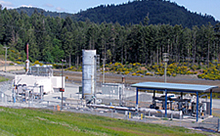What’s New
The CRD will contract Waga Energy, through its subsidiary Hartland Renewable Resource Group (HRRG) to design, build and operate a new CRD facility that will upgrade the biogas generated at Hartland Landfill to Renewable Natural Gas (RNG).
Under this contract, Waga Energy will both design and build the new biogas upgrade facility and decommission the site's current landfill gas to electricity plant by September 2024. Waga Energy will also operate and maintain the facility on the CRD's behalf for 25 years according to terms that include performance guarantees.
The WAGABOX® technology proposed for Hartland Landfill has been successfully implemented at 13 landfills in the past five years, with 12 additional facilities currently under construction in Europe and North America.
Under a purchase agreement approved by the BC Utilities Commission in June 2021, FortisBC will pay a fixed price per gigajoule for the RNG and will be responsible for the costs associated with injecting the RNG into its natural gas distribution system.
The new landfill gas upgrade facility will be fully self-funded through revenues from biogas sales.
Project Overview
In December 2019 the CRD Board directed staff to finalize an agreement to upgrade landfill gas generated at Hartland Landfill to RNG and sell it to FortisBC.
The RNG that will be produced at Hartland Landfill is a carbon-neutral energy made from capturing and upgrading the biogas released from decomposing organic waste in the landfill.
FortisBC will purchase this RNG and inject it into the region’s local gas system. As RNG mixes seamlessly into the existing natural gas infrastructure, it decarbonizes the natural gas supply, displaces equivalent volumes of conventional natural gas and lowers overall GHG emissions.
This project is expected to reduce the capital region’s greenhouse gas (GHG) emissions by approximately 450,000 tonnes of carbon dioxide over the next 25 years, the equivalent of removing 3,900 cars from the road or heating 3,000 homes with a heat pump instead of oil.
For more information on RNG, please visit www.fortisbc.com/rng.
Project Background
In 2004, Hartland’s Landfill gas-to-electricity plant began using landfill gas for green power generation and currently supplies electricity to approximately 1,600 homes in the region.
The volume of biogas being produced at the landfill has exceeded the capacity of this current system, and the existing infrastructure is reaching the end of its useful life. Two options were evaluated:
- expanding the existing power generation equipment to sell more electricity to BC Hydro
- installing a biogas upgrading facility at Hartland Landfill to upgrade this biogas to renewable natural gas

A lifecycle GHG assessment of this project found that decommissioning Hartland Landfill’s current electricity plant, a facility nearing the end of its life, and building a new RNG facility at the landfill would be the most effective beneficial use of this resource from a climate change perspective. The upgrade to renewable natural gas will not increase the footprint of Hartland’s current landfill gas-to-energy plant.
As communities transition away from fossil fuels, RNG will have a number of end uses where the shift to electricity is not technically or financially feasible. The CRD’s Climate Action Strategy includes fuel switching to RNG as a key tactic for meeting the organization’s corporate GHG emissions targets.
CRD staff are currently making a number of operational and design improvements at Hartland Landfill to capture more of the biogas produced by organic waste so that it can be upgraded. As a result, the need for a larger facility was identified during the procurement process for this project and new estimates anticipate GHG emission reductions of 450,000 tonnes of carbon dioxide over the next 25 years, a 73% improvement from initial projections of 260,000 tonnes in 2019.